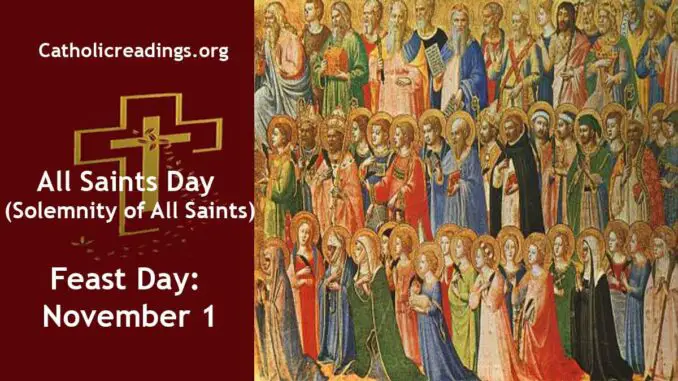Another name for All Saints’ Day is All Hallows’ Day or Hallowmas.
This is the feast that is celebrated in honour of all the known and unknown saints.
This day is usually designated as a national holiday in many countries that are historically Catholic.
We celebrate the solemnity of All Saints on November 1 every year in the Catholic Church.
| All Saints Day (Solemnity of All Saints) | |
|---|---|
 |
|
| Feast Day | November 1 |
All Saints Day History
Christians over time, especially in the 4th century, began to commemorate the martyrs who had died for their faith in Christ. Later on, in the 9th century, Churches in the British Isles slated this feast on November 1.
All Saints Day was started formally on May 13 in 609 AD, by Pope Boniface IV, when he consecrated the Pantheon, a former Roman temple in Rome, to the Virgin Mary and all the Martyrs.
However, because this day coincided with the Roman pagan festival of Lemuria, when the restless spirits of the dead were appeased, it was necessary to change it.
Around 731–741 AD, Pope Gregory III dedicated a chapel in Old St Peter’s Basilica on November 1, in honor of the Holy Apostles and of all saints, martyrs, and confessors. Pope Gregory IV, therefore, fixed the date at November 1 and extended the celebration to the whole Church.
In the Roman Catholic Church, the liturgical celebration starts on the evening of October 31 which is the All Saints’ Eve (commonly referred to as All Hallows’ Eve), and ends on November 1 night.
This is a Catholic Holy Day of Obligation, and Catholic faithful are obliged to attend Mass on that day, unless they are seriously impeded by serious reasons like illness.
The following day, November 2, becomes All Souls Day when we commemorate the souls of all the faithful departed.
The difference between All Saints Day and All Souls Day is that All Saints Day is for those who have attained heaven and All Souls Day is for those who have died but have not reached heaven yet.
Day by day, the Church pays a special veneration to the Holy men and women who have helped to establish, develop, and maintain it through their blood, labors, prayers, and virtues.
On top of those saints that the Church has honoured publicly by special designation and has included them in the General Roman Calendar, there are many more martyrs and pious faithful whose names are not recorded!
There are many people who have died having reconciled with God through penance and also many young innocent children who died as infants. Their holiness is only known by God and recognized only in heaven.
Now, we should not forget them because they still remember us in their intercessions. These people are still our ancestors, brothers, sisters, friends loved ones, and fellow Christians.
We have lived together in daily companionship and are now one family united with eternal love in Christ.
Commemorating the Solemnity of All Saints, therefore, reunites us with the communion of saints who then continue praying for us to God on a daily basis.
Halloween
In Old English, the word Hallow means Holy. This, therefore, means the evening before All Saints Day is called All Hallow’s Eve or Halloween.
Halloween has very strong religious roots but as time went by, it became diluted with secular practices and nowadays you cannot distinguish it from a secular ceremony. This has made people forget that the eve is a preparation for the main feast of All Saints Day.
In the Western world, especially in the United States, Halloween is celebrated by dressing in scary costumes with themes of death. However, children clad in scary costumes go door-to-door soliciting candy from their neighbors (trick-or-treating).
Related Links
Powered By SEO Experts
Follow @ReadingCatholic
